
Background information
Strength training: What are the benefits of training to muscle failure?
by Claudio Viecelli

Occlusion? Sounds good! Kind of like occasion. A great occasion to try it out. Little did I know it would be the workout from hell.
I’ve always wanted to write this and now the time has come: kids, don’t try this at home.
«Fancy trying out an occlusion training session?» Claudio Viecelli recently asked me lightly. He’s a molecular and muscle biologist at ETH Zurich. Occlusion? Sure, I’m in. What I didn’t know at the time: it would be the workout from hell. But I’ll get back to that later.
It’s a Friday morning and I have an appointment with Claudio and Dr Fabian Schaller, the medical director at Medbase WIN4, in Winterthur. Meanwhile, I’ve done a bit of googling about occlusion and blood flow restriction. Naively agreeing to do something before doing a Google search? That sounds like me alright. I want to find out more and ask the doc for details.
What’s occlusion training and how does it work?
** Dr Fabian Schaller, medical director at Medbase WIN4:** When occlusion training is carried out correctly, blood reaches the muscle via the arterial blood flow. However, as the veins are narrowed by the tourniquet, the blood is partially prevented from leaving the muscle. This allows the muscles to swell. Restricting the blood flow also leads to an accumulation of several metabolic products including lactic acid. These stimulate muscle growth. The direct exhaustion inflicted on the muscles forces the nervous system to recruit the largest, most rapidly contracting muscle fibres. These have the greatest capacity for growth.
Ultimately, it’s all about depriving the muscles of oxygen. This means you can tire out muscles faster with less weight. As a sports physician, I find this interesting. The method puts less stress on joints but still leads to hypertrophy, i.e. muscle growth. The way it’s done is that the upper part of each muscle group, such as the quadriceps, is tied with a cuff. This restricts the blood flow out of the trained muscle. What we’re talking about here is a workout at the physiological performance limit.
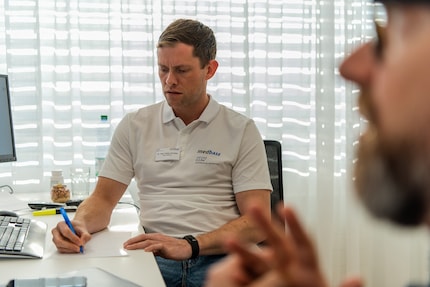
Are there any types of sport that are particularly suitable for occlusion training?
Yes, basically all sports that focus heavily on strength such as ice hockey or skiing. In other words, this kind of training is not very attractive for long-distance runners. Except maybe in rehabilitation after suffering an injury. So when the aim is to preserve the muscles but to go easy on the joints. Having said that, basically anyone can apply this method to their workout as long as certain risk factors have been excluded.
What are the risk factors?
All cardiovascular diseases, an increased risk of thrombosis or active cancer.
How dangerous is weight training when your blood flow is restricted? There are countless videos online in which buff boys work out their arms and legs to which they’ve applied tiny Thera band tourniquets.
Before your first occlusion training session you should carry out a health check with your doctor. It’s also important to have professional support during the first workout; from a movement or sports scientist, for example. This person knows how high the closing pressure is allowed to be and how long the tourniquet should be used for. Furthermore, you should only use medical cuffs, otherwise the risk of injury is very high. When applied incorrectly, one of the risks is injuring your nerve endings.
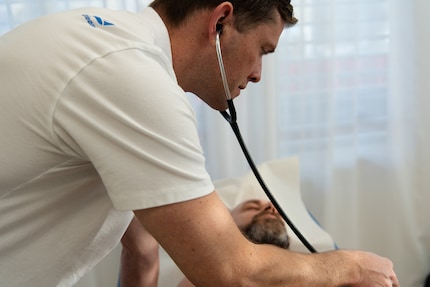
What else can go wrong when you restrict your blood flow?
A common complication when carried out incorrectly is fainting. You can lose consciousness if the tourniquet is released too quickly after the workout. But that’s nothing too dramatic. Having said that, it’s not advisable to train alone. The worst case scenario is a cardiac arrest. A very rare but serious complication.
A further advantage of occlusion training is the fact that it provokes both strength and endurance adaptations at the same time. The lack of oxygen caused by the occlusion ensures that certain proteins are stabilised. Namely those that increase the capillarisation of the muscles. This means you’re training aerobically and anaerobically at the same time – this is physiologically impossible under normal circumstances.
Aerobic energy metabolism describes a state in which the body consumes oxygen when burning carbohydrates and fats. By doing so, it generates energy for muscular activity. This happens during low-impact training such as slow endurance running, slow swimming, etc. The body activates its red muscle fibres for assistance because they absorb oxygen.
During fast, high-impact workouts, the body needs more energy in a very short time. And the aerobic energy production no longer covers the demand. That’s when the body extracts energy from carbohydrates without oxygen by means of lactic acid fermentation. This process produces lactate as a byproduct. And that’s roughly how the anaerobic metabolism works. Fats are not burned in this zone, because the body needs oxygen for this. The anaerobic energy yield is much lower and cannot be maintained for as long as the aerobic one. During prolonged exertion, the muscles acidify because of the lactate produced. This leads to a decrease in performance. Typical anaerobic sports include sprints or speed endurance running, weight lifting, but also yoga and any form of competitive sports during which the body is pushed to its physical limits in during short, intense phases. Anaerobic training taps into the white muscle fibres, which can increase their volume – just like the red ones.
Although simultaneous strength and endurance training sounds tempting, unconsciousness and cardiac arrests don’t. I start to have my doubts whether I should actually try out this training. But hey, in for a penny, in for a pound. First of all, I head to the treadmill for a ten-minute warmup. Next, cuffs are fitted around my thighs. The metaphoric oxygen tap is turned off.
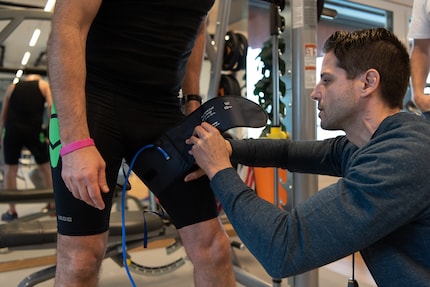
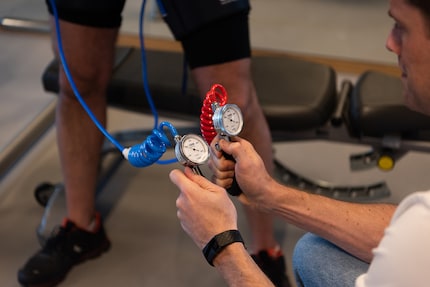
Next up are barbell squats. The weight load is 35 kilos. That’s about 30 percent of my one-reptition maximum. I ask Claudio how many sets at how many repetitions he wants me to do. Claudio rolls his eyes and replies: «Forget about sets and repetitions. What you need to do is train your muscles until you’re completely exhausted. When you start seeing stars or have a muffled sense of hearing, let us know and we’ll break it off. Otherwise you'll pass out. Your safeword is Galaxus. All set?» Yep, all set. Here we go.
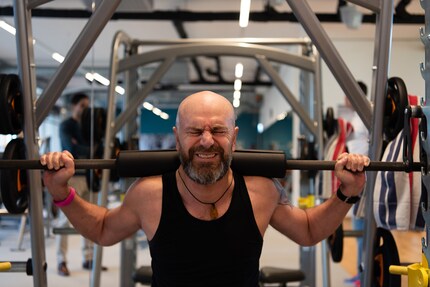
After twelve repetitions it’s over. That wasn’t so bad, I think to myself. What comes next hurts. Standing for three minutes. The tourniquet is loosened from 200 to 100 millimetres of mercury for one minute. Then it’s put back up to 200 mmHg again. This allows further metabolic products to accumulate in the muscles and accelerate growth. Time for the next round. There are no weights involved this time. Just the bar. It weighs a mere five kilos. This time, I manage eight repetitions. And that’s when things turn nasty. Another three minutes of standing, etc. and on to the next round. I manage four repetitions before reaching my absolute limit.
«Are you OK?» Claudio asks. «We're now going to slowly open the cuffs. Let me know if you start to feel sick.» He says some other stuff. But I can’t hear him. My head is one big ball of pain. Ischemic pain to be precise. And it’s really bad. I don't really know how to describe it. It’s as if your arm’s gone numb but you’re not allowed to move it and just have to put up with the sensation. Everything hurts. There’s not much else but pain. I want it to stop.
The blood starts flowing normally through my thighs and the pain subsides as quickly as it set in. Overall, the excruciating experience lasted about 15 minutes. I would call it a highly effective workout from hell. What was that the doc said at the beginning? Training at the physiological performance limit. An experience at the boundary. I do not wish to go there again. See you next time. Thank you, Claudio!
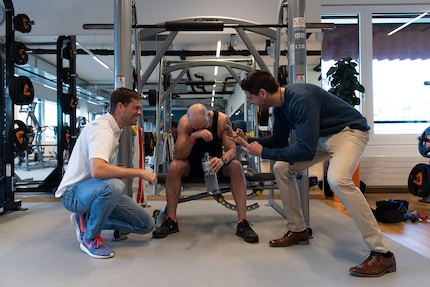
And thank you too, dear reader. Thank you for your loyalty. What’s that I hear? You don’t follow me yet? Now’s the time to change that. Just click here to view my author profile in 2020.
From radio journalist to product tester and storyteller, jogger to gravel bike novice and fitness enthusiast with barbells and dumbbells. I'm excited to see where the journey'll take me next.
Interesting facts about products, behind-the-scenes looks at manufacturers and deep-dives on interesting people.
Show all